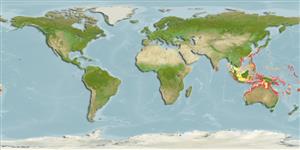Environment: milieu / climate zone / depth range / distribution range
Ecology
Marine; demersal; non-migratory; depth range ? - 46 m (Ref. 9790), usually ? - 10 m (Ref. 9790). Tropical
Western Central Pacific: Christmas Island to northern Queensland, Gulf of Carpentaria, Darwin, Shark Bay, Australia and Port Moresby, Papua New Guinea.
Size / Weight / Age
Maturity: Lm ? range ? - ? cm
Max length : 50.0 cm TL male/unsexed; (Ref. 9790); common length : 40.0 cm TL male/unsexed; (Ref. 9790)
Dorsal spines (total): 9; Dorsal soft rays (total): 11; Anal spines: 0; Anal soft rays: 11. A prominent pit present behind upper eye. Preopercular spines short, two subequal. Infraorbital ridge smooth over most eye, with a few short spines posteriorly. No dermal papillae on upper eye. Dorsal fin IX or I, VIII.
Found on the continental shelf, inshore region (Ref. 7300). Apparently associated with aquatic vegetation. Has been taken by trawl at depths from 15 to 46 m, frequently found at depths of 10 m or less (Ref. 9790).
Life cycle and mating behavior
Maturity | Reproduction | Spawning | Eggs | Fecundity | Larvae
Knapp, L.W., 1999. Platycephalidae. Flatheads. p. 2385-2421. In K.E. Carpenter and V.H. Niem (eds.) FAO species identification guide for fishery purposes. The living marine resources of the Western Central Pacific. Volume 4. Bony fishes part 2 (Mugilidae to Carangidae). FAO, Rome. (Ref. 9790)
IUCN Red List Status (Ref. 130435: Version 2024-2)
Threat to humans
Harmless
Human uses
Fisheries: subsistence fisheries
Tools
Special reports
Download XML
Internet sources
Estimates based on models
Preferred temperature (Ref.
123201): 24.9 - 29.3, mean 28.3 °C (based on 1467 cells).
Phylogenetic diversity index (Ref.
82804): PD
50 = 0.5625 [Uniqueness, from 0.5 = low to 2.0 = high].
Bayesian length-weight: a=0.00457 (0.00230 - 0.00908), b=3.09 (2.91 - 3.27), in cm total length, based on LWR estimates for this (Sub)family-body shape (Ref.
93245).
Trophic level (Ref.
69278): 3.9 ±0.7 se; based on size and trophs of closest relatives
Resilience (Ref.
120179): Medium, minimum population doubling time 1.4 - 4.4 years (Preliminary K or Fecundity.).
Fishing Vulnerability (Ref.
59153): Moderate vulnerability (40 of 100).
Nutrients (Ref.
124155): Calcium = 141 [52, 359] mg/100g; Iron = 1.22 [0.53, 2.77] mg/100g; Protein = 17.2 [15.1, 19.3] %; Omega3 = 0.213 [0.089, 0.635] g/100g; Selenium = 58.1 [25.9, 169.9] μg/100g; VitaminA = 33.2 [11.8, 94.4] μg/100g; Zinc = 0.871 [0.567, 1.375] mg/100g (wet weight);
